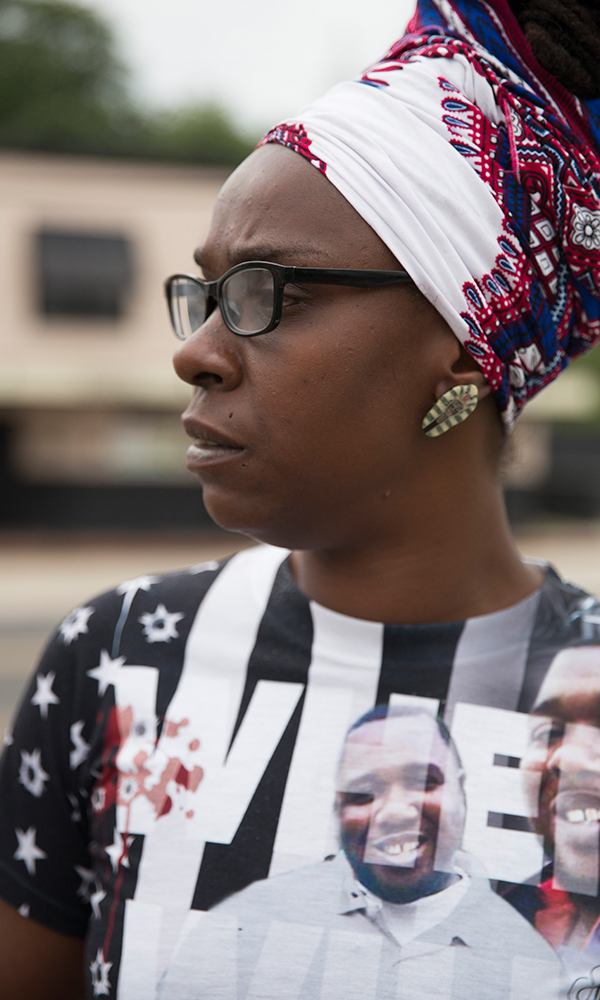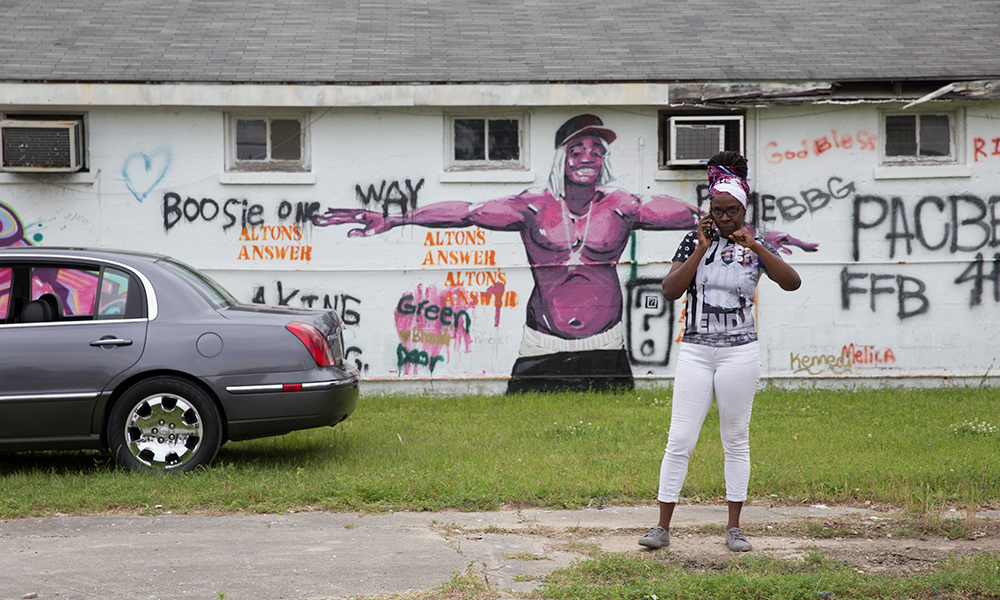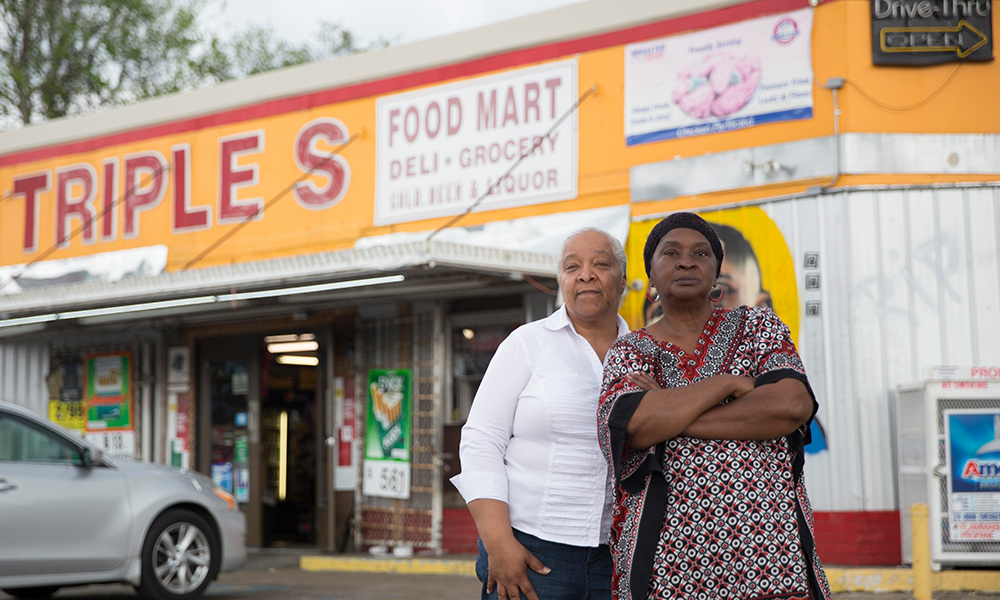BATON ROUGE, Louisiana — It is easy to imagine that the scene Thursday afternoon in front of the Triple S Food Mart on North Foster Drive in Baton Rouge was similar to the way it was the evening of July 5, 2016, before Alton Sterling was shot to death. Two men sat on a cooler beneath a ramshackle little tent chatting. Young people strolled into the store to buy after-school snacks. Cars pulled into the lot and people hopped out to do some light shopping.
Another man stood behind a table with stacks of CDs for sale, doing the same thing Sterling was doing when an encounter with police turned into a struggle and ultimately his death after one police officer shot him.
 Sterling’s face is painted on the outside front wall of the store, but otherwise there was little to indicate any of the turmoil that erupted in the wake of his death. In the days after the shooting, the store was transformed into both a memorial where people could mourn and a staging area for protestors mounting a fight against police abuse.
Sterling’s face is painted on the outside front wall of the store, but otherwise there was little to indicate any of the turmoil that erupted in the wake of his death. In the days after the shooting, the store was transformed into both a memorial where people could mourn and a staging area for protestors mounting a fight against police abuse.
But Tuesday, after Louisiana Attorney General Jeff Landry announced that there would be no criminal charges filed against Blane Salamoni and Howie Lake II, the two officers who gunned down Sterling, there was none of that energy. In contrast to the hours and days after the shooting, the store seemed exquisitely normal except for a small gaggle of activists milling around on the grass.
City prepared for outrage
Monday night city officials leaked to the local newspapers that they were preparing for massive civil unrest after the announcement. They called in backup police from jurisdictions from the northern part of the state in preparation for protests that rivaled those after the shooting in 2016. The city sent out an email telling city workers to stay home. It encircled the police department and courthouse with metal barricades. But there was no sign of that outrage and anger the day of the attorney general’s announcement.
But the activists who did go to the store stressed that they did not want the world to confuse Tuesday’s quiet with a lack of outrage. They did not want to send the message that relations between black neighborhoods and the police department have improved. The lack of protest in no way indicated a lack of disgust at the decision to not let a grand jury decide whether the two officers involved in Sterling’s shooting committed a crime, they said.
The decision not to prosecute is sending a message that when it comes to black people in Baton Rouge, the police can get away with murder, they said.
“The people aren’t reaching out to the police right now. Especially young black men,” said Rosalyn Scott, president of Ubuntu, a community organization. They are turning to what she called “street justice” and taking matters into their own hands.
School-to-prison pipeline
The path to the criminal justice system starts early here, Scott said.
“The system is set up for the young black people here to fail,” she said. “It is not designed to help us.”
It begins when you are in school, she said. If you get into any kind of classroom trouble, even if it’s something trifling, then you are sent to the discipline center where you are assigned a number. From there, she said, you are herded into the juvenile system and eventually into an adult prison.
“It all goes hand in hand,” Scott said.
For Jewel Lee, 31, Scott’s daughter, the message sent from Landry is clear.
“Black people in Baton Rouge have to watch your backs,” she said. “There’s no trust at all after today. If my life were in danger right now … I wouldn’t call the Baton Rouge Police Department. I wouldn’t do it, it’s that simple.”
Turned her protests into organizing

Nefertiti Assatta Shakur works for a community organization, which she joined to help change things herself.
Nefertiti Assatta Shakur, 36, who works for Ubuntu, said young people are too terrified of the police to ask for help. She said she joined the organization to help change things herself instead of trying to change what she sees as hopelessly corrupt city government.
She was out here from day one, she said, on the front lines zealously shouting her profanity-laced political feelings into a bullhorn outside the store. She would encourage other protesters to upend the system. But on Tuesday morning there was no bullhorn and no profanity.
Since the shooting, she said, she has channelled her energy she once used to protest into organizing. She credits her daughter, Kaimaiijeir, 16, for muting her anger at the system, and for encouraging her to look for ways to improve it. The people need the police, Shakur said, and the police need to have a working relationship with the people.
“If someone come up to us right now and pulls a gun, who are we going to call? The police,” she said.
Standing in the small crowd outside the Triple S were Constance Randolph and Lyn Hakeem. Their friendship began with a police shooting. Hakeem, 62, and Randolph, 61, met in 1992 after the shooting of unarmed 15-year-old Chauncey Thomas, they said.
They were waiting at a bus stop when Randolph approached Hakeem asking directions to a church. Realizing they were both headed to the same community meeting about how to respond to the shooting, the two women went together.
Now, years later, whenever someone else is killed by the police, Hakeem and Randolph go to the meetings, marches and protests together.
Ex-officer angered by response
Randolph was a police officer from 1979 to 1984, she said. She left the force because even though she loved the job, she wanted to help the community and felt she couldn’t do that as a cop. In the days after Sterling was killed, Randolph found herself on the front lines of the protests facing the police. She was angry with what she saw.
“You don’t engage with the people that you’re trying to hold back,” she said. “You don’t ... give tit for tat, and they were doing that. You don’t never take your shield and beat on it.”
In the wake of the Sterling shooting, the Baton Rouge Police Department launched a community ambassador program, made up of 20 people from the community who voluntarily applied. Hakeem is concerned about the application process and whether it will be representative of the community.
At one of the community meetings held about the program, Hakeem asked the officer leading the conversation about the process, she said. She asked multiple times.
She never got an answer.

Nefertiti Assatta Shakur stands in front of a mural of Alton Sterling next to the Triple S convenience store parking lot where he was shot and killed by Baton Rouge police officers in 2016.
‘They need to figure out a way’
Courtney Livous, 32, a relative of Sterling’s son, said the ambassador program was an attempt to build some trust.
“After today,” she said. “That trust, it’s gone.”
People are frustrated that little police policy has changed since the shooting. Livous, who has a degree in criminal justice, said she would never consider joining the Baton Rouge Police Department.
“They need to figure out a way to police our neighborhoods,” she said. “The youth no longer respect the police. You can’t just come into our neighborhoods and mace us and beat us and scream at us and then potentially shoot us and think that is going to work.”
When she attended Woodlawn High School, Livous said, she had friends who were white and black, and everyone got along. She said those same white friendships have disintegrated since the shooting. They call her a nigger now, she said, and are ignorant. They tell her Alton Sterling deserved what he got.
“You have to understand this is a city of ZIP codes. And we are judged by our ZIP codes. There is a serious racial issue in the city of Baton Rouge and it needs to be solved quick,” she said. “Before things get out of control.”
Hello. We have a small favor to ask. Advertising revenues across the media are falling fast. You can see why we need to ask for your help. Our independent journalism on the juvenile justice system takes a lot of time, money and hard work to produce. But we believe it’s crucial — and we think you agree.
If everyone who reads our reporting helps to pay for it, our future would be much more secure. Every bit helps.
Thanks for listening.
